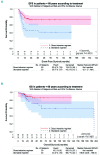Mediastinal gray zone lymphoma: clinico-pathological characteristics and outcomes of 99 patients from the Lymphoma Study Association
- PMID: 27758822
- PMCID: PMC5210245
- DOI: 10.3324/haematol.2016.152256
Mediastinal gray zone lymphoma: clinico-pathological characteristics and outcomes of 99 patients from the Lymphoma Study Association
Abstract
Mediastinal gray zone lymphoma, B-cell lymphomas with intermediate features between classical Hodgkin lymphoma and primary mediastinal B-cell lymphoma, have not been well described in the literature. We report the clinical characteristics and outcomes of a large retrospective series of 99 cases centrally reviewed by a panel of hematopathologists, with a consensus established for the diagnosis. Cases were defined as classical Hodgkin lymphoma-like morphology (64.6%) with primary mediastinal B-cell lymphoma immunophenotype, primary mediastinal B-cell lymphoma-like morphology (30.3%) with classical Hodgkin lymphoma or composite (5.1%) (synchronous occurrence of classical Hodgkin lymphoma and primary mediastinal B-cell lymphoma). The median age was 32 years (13-83 years); 55% were women. Thirteen of 81 evaluable cases (16%) were Epstein-Barr virus-positive. Twenty-eight percent of patients presented primary refractory disease (progression under first-line treatment or relapse within one year). The 3-year event-free and overall survival rates were 63% and 80%, respectively. Patients treated with a standard regimen (RCHOP/ABVD) had worse event-free survival (P=0.003) and overall survival (P=0.02) than those treated with a dose-intensive chemotherapy (high-dose RCHOP/escalated BEACOPP). Rituximab added to chemotherapy was not associated with better event-free survival (P=0.55) or overall survival (P=0.88). Radiotherapy for patients in complete remission had no impact on event-free survival. In multivariate prognostic analysis, ECOG-PS and anemia were the strongest factors associated with a shorter event-free survival and overall survival, respectively. In conclusion, this report describes the largest series of mediastinal gray zone lymphoma. Our data suggest that a dose-intensive treatment might improve the outcome of this rare and aggressive disease.
Copyright© Ferrata Storti Foundation.
Figures



Similar articles
-
Mediastinal Gray Zone Lymphoma: A Wider Category Than We Think?Int J Surg Pathol. 2016 Aug;24(5):382-93. doi: 10.1177/1066896916635816. Epub 2016 Mar 7. Int J Surg Pathol. 2016. PMID: 26957476
-
MACOP-B and involved-field radiotherapy is an effective and safe therapy for primary mediastinal large B cell lymphoma.Int J Radiat Oncol Biol Phys. 2008 Nov 15;72(4):1154-60. doi: 10.1016/j.ijrobp.2008.02.036. Epub 2008 May 9. Int J Radiat Oncol Biol Phys. 2008. PMID: 18472357 Clinical Trial.
-
Gray zone lymphoma with features intermediate between classical Hodgkin lymphoma and diffuse large B-cell lymphoma: characteristics, outcomes, and prognostication among a large multicenter cohort.Am J Hematol. 2015 Sep;90(9):778-83. doi: 10.1002/ajh.24082. Am J Hematol. 2015. PMID: 26044261
-
Difficult Diagnosis between B Cell Lymphoma and Classical Hodgkin's Lymphoma.Bol Asoc Med P R. 2015 Jul-Sep;107(3):98-101. Bol Asoc Med P R. 2015. PMID: 26742206 Review.
-
Primary mediastinal large B-cell lymphoma: clinical study of a distinct clinical entity and treatment outcome in 20 patients: review of the literature.Am J Clin Oncol. 2004 Jun;27(3):312-6. doi: 10.1097/01.coc.0000071417.95845.06. Am J Clin Oncol. 2004. PMID: 15170155 Review.
Cited by
-
Anaplastic Diffuse Large B Cell Lymphoma: A Single Center Experience.Indian J Hematol Blood Transfus. 2019 Jul;35(3):557-560. doi: 10.1007/s12288-019-01096-8. Epub 2019 Feb 9. Indian J Hematol Blood Transfus. 2019. PMID: 31388273 Free PMC article. No abstract available.
-
An overview on the differential diagnostics of tumors of the anterior-superior mediastinum: the pathologist's perspective.Mediastinum. 2019 Feb 22;3:6. doi: 10.21037/med.2018.12.01. eCollection 2019. Mediastinum. 2019. PMID: 35118235 Free PMC article. Review.
-
Clinicopathologic consensus study of gray zone lymphoma with features intermediate between DLBCL and classical HL.Blood Adv. 2017 Dec 11;1(26):2600-2609. doi: 10.1182/bloodadvances.2017009472. eCollection 2017 Dec 12. Blood Adv. 2017. PMID: 29296913 Free PMC article.
-
[Gray zone lymphoma: five cases report and literature review].Zhonghua Xue Ye Xue Za Zhi. 2023 Mar 14;44(3):242-246. doi: 10.3760/cma.j.issn.0253-2727.2023.03.011. Zhonghua Xue Ye Xue Za Zhi. 2023. PMID: 37356987 Free PMC article. Review. Chinese.
-
Clinical genomic profiling of novel grey zone lymphoma paired lesions with sequential central nervous system involvement in two adolescent patients.Haematologica. 2021 Sep 1;106(9):2533-2536. doi: 10.3324/haematol.2021.278936. Haematologica. 2021. PMID: 34162180 Free PMC article. No abstract available.
References
-
- Swerdlow SH, Campo E, Harris NL, et al. WHO classification of tumors of haematopoietic and lymphoid tissues. 4th ed. Lyon: International Agency for Research on Cancer, 2008.
-
- Traverse-Glehen A, Pittaluga S, Gaulard P, et al. Mediastinal Gray Zone Lymphoma: The Missing Link Between Classic Hodgkin’s Lymphoma and Mediastinal Large B-Cell Lymphoma. Am J Surg Pathol. 2005;29(11):1411–1421. - PubMed
-
- Minami J, Dobashi N, Asai O, et al. Two cases of mediastinal gray zone lymphoma. J Clin Exp Hematop. 2010;50(2):143–149. - PubMed
-
- Gualco G, Natkunam Y, Bacchi CE. The spectrum of B-cell lymphoma, unclassifiable, with features intermediate between diffuse large B-cell lymphoma and classical Hodgkin lymphoma: a description of 10 cases. Mod Pathol. 2012;25(5):661–674. - PubMed
MeSH terms
Substances
LinkOut - more resources
Full Text Sources
Other Literature Sources

